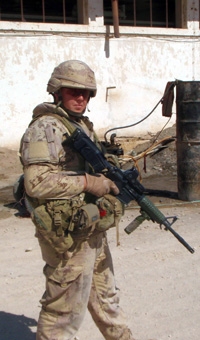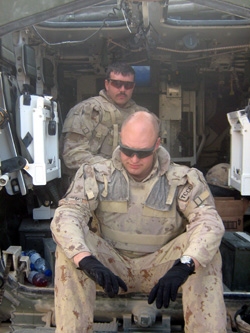
|
Quiet Canadian PatriotismOriginally published August 31 2010 Why Does Canada, Alone, Have a Highway Of Heroes? This is a very interesting and fascinating question, which could probably fill an entire Ph.D. Thesis and still not be fully answered. One would need to delve into history, psychology, sociology and cultural anthropology to even begin to understand this phenomena that has morphed into a sense of unbridled national pride .. something that Canadians rarely demonstrated in the past.  I am going to attempt to keep the answer to this question short and simple, if only because a blog post needs to be kept below or not much over 2,000 words. Any more than that and eyes start to glaze over and readers click off in search of some other means of instant gratification. So, right off the bat, let's give some possible answers to this question - Why does Canada, and NO other country, have a Highway Of Heroes?
Does that answer the question for you, in short form? I am going to continue on with this article and expand a bit on the history and cultural influences that drive this phenomenon. If you would prefer to learn more through audio-video, rather than reading, just follow this link to the YouTube search listing for Canada Highway Of Heroes. There are scores of videos to watch. What Is The Highway Of Heroes? The Highway Of Heroes is a 172 kilometer [107 mile] stretch of the Macdonald-Cartier Freeway, more commonly known as Highway 401, located in Ontario, Canada. It begins at Glen Miller Road in Trenton and ends at the intersection of the Don Valley Parkway and Highway 404 in Toronto. You can view the Google Map here. Why Is It Called The Highway Of Heroes? After Canada's participation in the Korean War ended in 1953, we became a nation of Peacekeepers. In fact, Canada became known as "Peacekeepers To The World". For many generations, Canadians have only known their military to be peacekeepers. So it was a shock for the nation when Fallen Soldiers, killed in battle, began arriving back on Canadian soil in 2002. This was the first time ever that Fallen Soldiers had been repatriated to Canada. In World War I, World War II and the Korean War, the casualties had been buried in-country. But now they were "coming home". The government was not prepared. The military was not prepared. Canadians were not prepared. All returning Fallen Soldiers are flown into Canadian Forces Base Trenton where grieving families, military personnel and government dignitaries receive them. From there, a funeral procession leaves the base and heads to Toronto, arriving at the Chief Coroners Office at the Centre for Forensic Sciences in the downtown. They get there by driving down the 401. The first four Soldiers were killed April 18 2002, all from the 3rd Battalion Princess Patricia's Canadian Light Infantry. They arrived at CFB Trenton a few days after and were received by family and friends. Because these were the first Fallen Soldiers brought back to Canada, the media was all over it. Some people in Trenton were watching the coverage and, on a whim, decided to go to the highway overpass at Trenton. There were about 30 people on the overpass that first day, including two police officers. Word of this occurrence spread and, when subsequent Fallen Soldiers arrived for the journey to Toronto, more and more people began lining the highway or standing on the 50 overpasses along Hwy 401 to show their respect and thanks. And they continue to spontaneously come out by the thousands to this day, in burning heat, freezing cold, rain, sleet and snow.
No other country has anything like the Highway Of Heroes. In fact, countries such as the United States of America and Great Britain go to great pains to hide away the return of their Fallen Soldiers to home soil. This is further explained in this article in the National Post. [Ed Note: article was removed from their server without explanation]
Personally, I feel that Canadians should stand proud for the way we receive our Fallen Soldiers. History Of Canada At War World War I was the catalyst that first brought Canadians together as a nation. Official Confederation was in 1867, but we were still very much a Dominion of Britain. In fact, you can narrow this catalyst down to the Battle Of Vimy Ridge. That battle was a stalemate. The British, French and amalgamated armies had not been able to break the German lines. Then, the idea was hatched to bring all four Canadian divisions together into one corps under Canadian command, then send them against the German trenches. The battle began on April 9 1917. After fierce, almost inhuman fighting the Canadians were in complete control of the Ridge by nightfall, April 12 1917. The Canadians also fought bravely at the Second Battle of Passchendaele and the Battle of the Somme. Canada's total casualties during WWI stand at 67,000 killed and 173,000 wounded. These battles became a Canadian nationalistic symbol of achievement and sacrifice, which continues today. World War II saw Canada enter as an independent nation, with its' own army, air force and navy. We were instrumental in establishing supply routes to Britain on the sea and in the air that literally, quite literally, saved their nation. By the end of the war, Canada had the 3rd largest navy in the world, and the 4th largest air force, having trained over 48,000 pilots from various countries in Canada. Canadians were fully involved with the invasion of Sicily, and stayed on to fight up through the mountains of Italy. We sent 5,000 troops, along with 1,000 British, into the disastrous landing at Dieppe. It was a lesson well learned, though, for our later participation in D-Day at Juno Beach. On June 6 1944, we landed at Juno Beach and penetrated farther inland than any other landing sector. Our soldiers then fought viciously against the best German divisions in France before veering north and liberating Holland. There is an ongoing tale that the Germans were terrified of the Canadians, perhaps harkening back to the battles of WWI. Canadian losses in the war were over 45,000 killed and 58,000 wounded. Our participation in WWII solidified our status as an independent nation. Korea, 1950 - 1953. We tend to forget about the Korean War, but Canadian Forces acquitted themselves quite well in that confrontation. Especially of note is the role of the 2nd Battalion, Princess Patricia's Canadian Light Infantry (2PPCLI) at the Battle of Kapyong. I'm not going to repeat the whole story [read it here], but suffice to say that the Canadians fought with unheard of valour and distinction, refusing to give up, stopping the Communist attack and in effect saving Seoul from being overrun. This led to 2PPCLI being awarded the United States Presidential Unit Citation for their bravery under fire, a badge that every 2nd Patricia (including our son) still wears on their uniform every day. As earlier mentioned, after Korea was a long period of Peacekeeping. Things didn't always work out well in that role, though. There was the unfortunate incident in Somalia (who in their right minds would send Special Forces troops in to act as jail guards?!?) and there was the heartbreak of Rwanda, where our soldiers were ordered to stand aside and watch genocide be perpetrated against a people. I think that's probably why, in Bosnia, they refused to stand aside and fought the Battle of Medak Pocket, again involving the 2nd Battalion Princess Patricia's Canadian Light Infantry. You've never heard of Medak Pocket? Not many have. It was kept pretty much under wraps. You can read the full official version here, or view an excellent, chilling, two-part video documentary here. You will shiver.  I think that battle was the end of the peacekeeping ideal for the Canadian Forces. We are not suited to it. We are fighters. And thus we come to Afghanistan. The Americans were pulling out after the initial invasion, having set their eyes on Iraq, and Canada arrived as part of the ISAF international force, along with many other countries. The ISAF forces were divided up throughout the country, and guess what part of Afghanistan that Canada was assigned to? Kandahar Province, homeland and heartland of the Taliban, right on the borders of Pakistan and Iran. It was a huge task, but we were up to it, though ill-equipped at the time. We are much better equipped now. The Taliban learned soon enough not to engage our Soldiers in direct battle, because they got their asses handed to them every time they did. So they resorted to suicide bombers, roadside bombs and IEDs, which is how the vast majority of Canadian Soldiers have been killed. Ask any senior American officer who has commanded Canadian troops in Afghanistan and they will tell you that any regular Canadian soldier is the equivalent of the best US Marine. That's a plain honest fact. We have the finest fighting Soldiers in the world. And I would venture that you can extend that to all the other branches of the Canadian Armed Forces as well. So that brings us full circle, back to the original question, Why does Canada, and no other country, have a Highway Of Heroes? If you have read, watched and listened to everything I have presented here, then you know the answer to that question. Summing Up It has taken me many hours to write this, because every time I review the Highway Of Heroes videos or read the online articles I get emotional and it clouds me up, as our oldest son has just returned from a tour in Afghanistan. He was assigned to the Force Protection Unit of the Kandahar Provincial Reconstruction Team. On the late afternoon of December 30 2009 my wife and I were in our van driving down the main street in our town. The radio news came on with a report that four Canadian Soldiers and a Canadian journalist had been killed by a roadside bomb while driving through Kandahar in a LAV. The report went on to say that the Soldiers where from the Force Protection Unit of the Kandahar Provincial Reconstruction Team. My wife and I looked at each other, not daring to breathe. I swear our hearts stopped. Then I remembered the Notification Protocol for Canadian Soldier deaths and I said to her "If it was him, we'd already know." They always notify immediate kin before anything is made public. But those are several seconds I never want to re-live.  That LAV was from our sons' Platoon. He and his crew were at Base, loitering around their LAV, idly cleaning their weapons, listening to the comm when the report came in ... One LAV hit, five VSM, [location]. They immediately got their stuff together, jumped in their LAV and raced to the scene. It had been a huge explosion. All they could do was stake perimeter protection and start picking up the pieces of the LAV that didn't need a crane to move. [Ed Note: VSM means vital signs missing] So when I saw the media coverage of the motorcade driving up the Highway Of Heroes, carrying the grieving relatives of the four Soldiers killed in that blast, and all the people standing on the overpasses honouring them, all I could think of was "There but for the grace of God go I". It was the pure chance of scheduling that kept my sons' LAV at Base that day. It could have been him, so easily. So for me, it's personal. There should be, and needs to be, a Highway Of Heroes. You can view a listing of the Canadian Fallen Soldiers here. POSTSCRIPT September 1, 2011 at 9:18 pm It's been a year since I wrote this. There were many good comments to this post, but they were lost when the database corrupted, or was sabotaged. Anyway, I have one addendum to add. I just found out a little while ago that my son, Brian, dug Private Chidley out of the LAV wreckage when they arrived on the scene. This is the first time he has spoken about it. We were visiting him and his mother saw this knife in a sheath, and it was all dusty and dirty. She, being a mother, began chastising Brian for not cleaning his equipment. He said "That's the knife I used to dig out the ground to get Chidley out of the LAV. I'll never clean it." Not another word was said by anyone for several minutes. Bibliography YouTube Videos
Online Articles
Thank you for being here. It means a lot. Randall Hawes |
Contact me:NAVIGATION:BROWN PAPER TICKETS |
Page last updated on: April 2 2015. Copyright © Fly Free Biz 2009 - 2019. World Wide Rights Reserved.
All pictures, texts, audio, video, images and graphics are copyright to their respective owners and cannot be used without permission.
